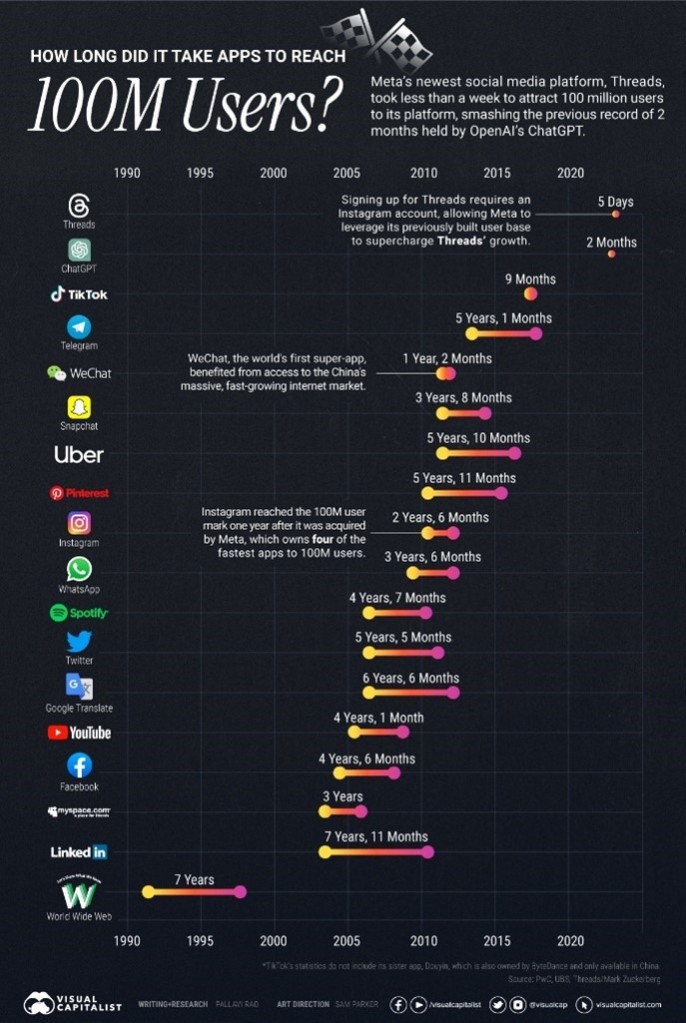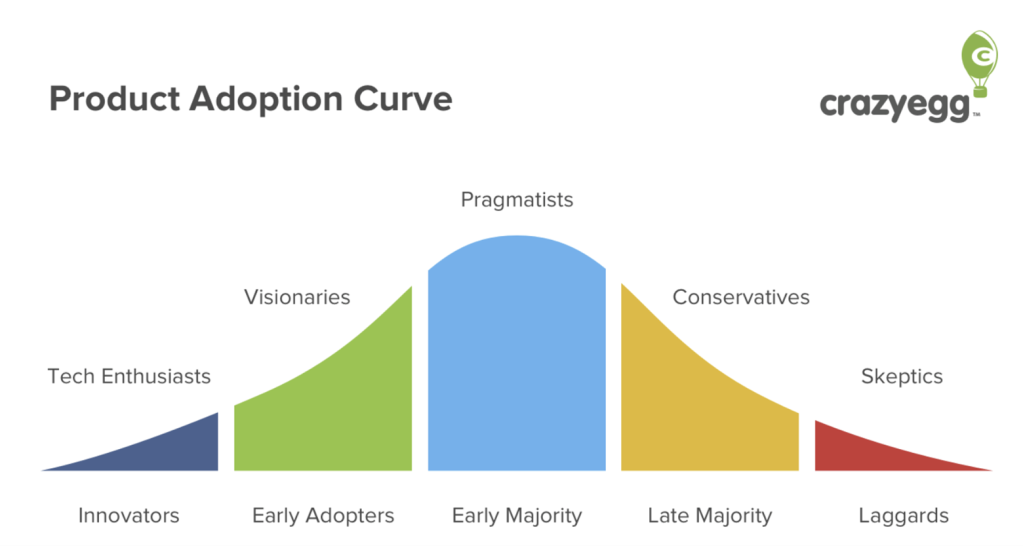The idea in 60 seconds :
- Technology rolls out more and more quickly.
- A variety of factors influence how quickly a technology is adopted.
- Ease of use, cost / benefit, awareness and infrastructure requirements affect the speed.
- Voice Assistants on phones are the easiest possible technology to use, they’re free and offer a significant benefit.
- As a result they will roll out extremely quickly.
- This could leave businesses struggling to adapt and cause a problem for regulators.
When Conversational AI & Assistants Happen, Everything Will Happen Very Quickly
In other articles, I’ve proposed :
- Conversational Interfaces are important and will become the next generation of Computer Interfaces.
- That means they are likely to become a major access point for individuals to the internet.
- Smartphones will soon have Assistants to help you do your bidding.
- Increasing autonomy on the part of assistants will turn them in to agents.
- Many visitors to existing websites will then be Assistants, not humans.
- Businesses will adapt by enabling eServices which help Assistants help their users Evaluate, Buy and Self Service their products.
In this article, I want to examine another question. When these changes happen, how long will it take for them to propagate through society and what are the implications of that?
Technology Rolls Out More and More Quickly
The time it took for new technologies to reach 50 / 100 million users has been decreasing over time. I won’t dwell on this, I think the concept is quite well understood and there’s a chart (below) to explain it.

The fact that technologies are rolling out more and more quickly as now quite well understood.
Source : https://www.visualcapitalist.com/threads-100-million-users/
- The telephone: It took the telephone 75 years to reach 50 million users, from 1876 to 1951.
- The television: It took the television 22 years to reach 50 million users, from 1948 to 1970.
- The personal computer: It took the personal computer 16 years to reach 50 million users, from 1975 to 1991.
- The internet: It took the internet 4 years to reach 50 million users, from 1995 to 1999.
- The mobile phone: It took the mobile phone 3 years to reach 50 million users, from 2002 to 2005.
- Social media: It took social media less than 2 years to reach 50 million users, from 2006 to 2008.
Through What Process Is Technology Typically Adopted?
There is a classic marketing chart to show the way people and society adopt new technologies.
- Innovators: A small group of people who are the first to try the new product.
- Early Adopters: A slightly larger group that is open to new ideas and adopts the product early in its lifecycle.
- Early Majority: A larger segment that adopts the product once it has been proven by the early adopters.
- Late Majority: This group is skeptical and only adopts the product after a significant portion of the population has tried it.
- Laggards: The last group to adopt the product, often resistant to change and only adopting due to necessity or lack of alternatives.

Everett M. Rogers’ Product Adoption Curve was ‘Crushed’ By the Ease Of Use Of ChatGPT
Source :
What Factors Influence How Quickly Conversational Interfaces on Smartphones are Adopted?
“While ChatGPT is underpinned by complex technology, its visual interface is incredibly intuitive: you simply enter text into a text box, just like you would on Google. This streamlined interface has allowed people of all ages and backgrounds to instantly engage with it.”
- Ease of Use: Personally, I think this is key to the whole question of how quickly a technology is accepted. I think it is the ease of use which will crunch the product adoption curve for Assistants on smartphones to an almost vertical line. Voice Interfaces are very easy to use, even for people with no experience with AI. When a technology is user-friendly, intuitive, and convenient, it significantly enhances the likelihood of widespread acceptance. Just look at the iPhone’s user-friendly interface.
- The availability of infrastructure : No infrastructure is required (by the user) to start using Voice Assistants.
- Benefit : When a technology has a positive impact on work and daily life, it is more likely to be adopted quickly.There’s a cost benefit to adopting a new piece of technology. When it’s easy to use, people look at it and think “This thing can help me, I can learn it quickly and it won’t take much effort.”
- Cost of the technology : Solar panels are a good idea. I think most people would use them if they could. In the long run, users save money. They’re just expensive up front.
- Media coverage: ChatGPT was also widely covered in the media, which helped to raise awareness of the product and its capabilities.
Now apply those factors to Assistants on Smartphones
Those technologies which got to 50 / 100 million users are specific technologies and of course. Uber. Spotify and so on. Here, I am talking about a category – AI Assistants. I’m raising the issue of a concept rather than a product. My point, really, isn’t that Voice Assistants will be the fastest rollout ever. They might be but that’s not my point. My point is, when Smartphones with Assistants and Agents on them are released, global consumer adoption will be extremely fast.
Voice Assistants are :
- Easy To Use: As easy to use as talking and even those laggards from the Product Adoption model can do that.
- No Infrastructure : All that is required to use them by way of ‘infrastructure’ will be a Smartphone and as we have seen (link to article 3) there are currently 5 billion smartphones on the planet.
- Free : Free to use. It could be that phones require new chips or new hardware. As I mentioned before, phone sales have plateaued. There used to be a good reason to go out and buy a new device.
- Big Benefit : They’ll help us perform typical daily tasks. To get them done all we will have to do is vaguely describe an abstract idea. Agents will make the completion of those tasks significantly easier (benefit)
- No $ Cost : At least for the basic version and initially.
- There will likely be a media storm : Driven by Apple, Google, Open AI And Humanity all of which want to sell us new devices. The media will inform us and word of mouth will drive the message home.
Conclusion : So what?
“How did you go bankrupt?”
Two ways. Gradually, then suddenly.”
― Ernest Hemingway, The Sun Also Rises
Consumers make up 60-70% of Western economies and very soon, a lot of them are going to have and be using Voice Assistants. Change happens slowly then quickly. It appears that every one of the factors which drives the fast adoption of technology is in place to make Assistants ubiquitous, quickly.
As a thought experiment, let’s just say everyone now has an AI Assistant. Take a second to think what the world is like. People are getting a lot more done and they are using their phones to do it. Everywhere you look, people are conversing with their phone either typing things in or talking to them (depending on the subject they’re discussing.) To that already extremely fast rollout and global cultural change, add this.
As businesses respond to a world with Assistants, 2 linear trends overlap.
- Assistants/Agents are becoming increasingly autonomous.
- eServices which are enabled by businesses on their own websites.
It’s a positive feedback look. The more we use Assistants, the more websites roll out eServices and the more useful our Assistants are. In the background, every month, Assistants are developed further so they are more autonomous and capable.
Overlapping 2 linear trends results in exponential growth and exponential growth is hard for humans to track. We’re not designed that way. For the sake of business and consumers, governments might regulate this overwhelmingly fast change. Given it’s size and importance, that might be a good thing.
